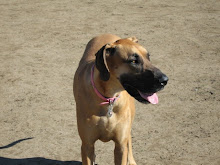One of the key principles of dog training is the principle of “conditioned response.” The idea is that you can set up your dog’s environment in such a way that it learns to abandon its destructive behavior through its own mistakes rather than by your instruction. Below are two common examples of problem dog behaviors and how the princple of "conditioned response" can be used to resolve them.1. My dog is digging up my yard. How can I stop this destructive behavior? First, you must purchase some chicken wire from your local hardware store and some styptic powder from you local pet store. Before you begin, you must observe your dog’s favorite digging spots and pinpoint them in your mind. Then, you must remove your dog from the yard, and you must not allow it to watch you as you set up its environment. Cut about a 4 by 4 foot section of chicken wire and plant it under the dirt in all the locations where you dog likes to dig. Once you’re finished, release your dog and wait for the conditioned response. More than likely, your dog will go back to the locations where it dug before and proceed to dig as usual. Except now, it’s going to learn a novel lesson. Namely, that digging is going to cause it serious discomfort and pain. Once your dog associates the condition (digging) with the negative response (pain) it will automatically stop its destructive digging habit. There is, however, one drawback to this technique. If you have an aggressive digger, then you should monitor your dog for any cuts or bruises. That’s where the styptic powder comes in. If you notice a cut in your dog’s paws, gently pour the styptic powder on the cut and allow it to cauterize the bleeding. Within a matter of days, you can conditon your dog to abandon its destructive digging habit by using the principle of "conditioned response."2. My dog chews my furniture, my shoes, and my valuable belongings. What can I do to end this destructive behavior? Go to your local pet store, and purchase a spray bottle of bitter apple. Remove your dog from your house and do not allow it to see you set up its environment. Spray your valuables (i.e. furniture, shoes, and socks) with bitter apple and place them in locations that your dog can easily access. Then allow it to come in and let the trap do the rest. As usual, your dog will go back to its old habit and start to chew its favorite shoe or furniture. But now, it’s going to get a bitter surprise. Your dog will associate the condition (chewing) with the negative response (bad taste) and it will stop its destructive chewing habit. It's important to remember, however, that all dogs need to chew, so you must repeat this process a second time. Now, you must place your dog’s favorite chew toys next to the items that were sprayed with bitter apple. This time, your dog will be reconditioned to chew its own toys rather than your valuable possessions. Thus, by conditioning your dog, you can positively reinforce a good habit (chewing designated toys) over an undesirable one (chewing your valuable possessions). As you can see, by applying the principle of “conditioned response” you can teach your dog exactly what you want without ever getting frustrated with the training process.
About The Author Armen T. Ghazarians offers advice and articles for those interested in training their dogs like the professionals. His blog http://www.newdogtrainingsecrets.com
Keywords: pet meds, dog toys, dog beds, dog collars, pet supplies, dog training, dog bowls
Subscribe to:
Post Comments (Atom)




No comments:
Post a Comment